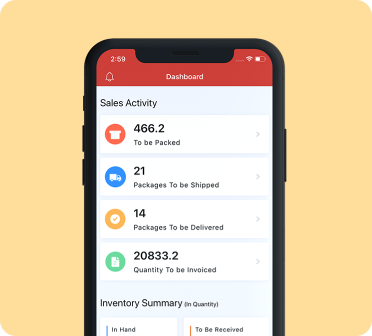Warehouse Management Tips
A warehouse is a busy space, between the racks and shelves of inventory and the bustle of the warehouse staff, equipment, vehicles, and handheld devices. With so many activities being carried out simultaneously in such a large space, it can be hard to figure out the practices that would help you manage these operations more effectively.
Here, we have assembled a list of tips that can help you to optimize your warehouse operations, including inventory organization, warehouse space management, quality control, employee management, and shipping. Whether you’re a warehouse manager or an entrepreneur looking for ways to make your job easier, check out these tips.
1. Invest in Warehouse Management Software (WMS)
Even if diverse operations are performed in a warehouse, the data generated is synchronous. For a warehouse to function effectively, item data needs to stay consistent through all of the diverse operations being performed. Stock information like SKUs, item counts, item types, and categories, which you note down when the items enter your warehouse, will be carried forward when it’s time to ship the items for delivery. In this situation, if you’re maintaining manual records you’ll always be vulnerable to risks like losing data and making manual errors. Warehouse management software automatically maintains a database of item information which is fed into your invoices, packages, and shipping labels when they’re generated. This keeps your item-related information safe and accurate, as well as freeing you from the task of checking the data for consistency. Additionally, if you use a cloud-based warehouse app, you can keep an eye on your warehouse activities even when you’re out of the office.
2. Classify your inventory
This is one of the most crucial steps that you can follow to start organizing your inventory. There are numerous ways that you can classify your inventory, so we won’t get into all of them here.However, if we could choose only one technique for classifying inventory, it would have to be ABC analysis. ABC analysis is used to classify items based on their sales frequency and storage value. Sales frequency is the average number of days it takes to sell the items, and storage value is the cost of storing the product in the warehouse.
Category A: High storage value, low sales frequency
Category B: Moderate storage value, moderate sales frequency
Category C: Low storage value, high sales frequency
For instance, if you sell high-end knife sharpeners and ordinary kitchen scissors, the knife sharpeners will probably fall into category A because they’ll sell fairly infrequently. Once you know that, you might decide to store them at the back of the warehouse and protect them from rusting since they may be in storage for a while. The kitchen scissors will probably be in category C, so you might decide to store them in an easily-accessed part of the warehouse and to forgo moisture barriers since the items won’t be sitting for very long.
3. Develop a safety culture
A safety culture is an active process of setting and following safety standards within the organization, from the top of the hierarchy all the way to the bottom. It reduces the risks caused by accidents, establishes a preference for higher safety, and also encourages employees to report incidents so that they can be used to refine safety processes for the future.
Does a small business need to develop a safety culture? The answer is YES. Even if you have a small warehouse with limited staff, you can still engage your employees in discussions related to hazard management, safety practices, personal protective kits and equipment, and preventing injuries. This will help you to develop a safe working environment and avoid putting safety on the back burner.
To start to develop a safety culture:
- Plan and schedule weekly or monthly meetings with your staff
- Train employees on the latest safety measures
- Appoint a safety leader in each team
- Measure performance with the help of incident reports
- Recognize best performers and highest contributors to workplace safety
4. Keep it clean
A clean warehouse is hygienic, safe, and easy to operate. However, for a large warehouse it can become a challenge to maintain cleanliness. Having said that, there are some simple practices that you can follow to keep your warehouse clean. Here are a few to get you started:s
- Plan a cleanliness routine for your warehouse
- Maintain a checklist of the areas that have been cleaned
- Try to establish a ‘cleanliness first’ culture
- Assign appropriate garbage cans depending upon the nature of the trash
- Use dust-proof material to reduce the accumulation of dust
5. Redesign your shipping area
Your shipping area is the place where all the packing and dispatch activities are handled. In this section of the warehouse, the time taken to pack and ship the products should be minimal. While regular employee training can keep your staff updated on the latest practices, there are some steps that you can follow to redesign your shipping area to make the shipping process even faster.
-
Place fast-moving items near the shipping bay so that very little time is spent in picking items from the shelves
-
Label shelves clearly so that warehouse staff can quickly identify the right item
-
Assign an area close to the shipping station for keeping the packing materials
When you follow these steps, you automatically start moving toward a smarter, more organized way of managing shipments. Down the line, once a good routine is established, you can think about documenting this process, setting time goals, and measuring staff performance.
6. Enable smart picking
Picking is the process of physically taking the items for an order off the shelves in the warehouse. There are many ways of doing this, and you can select the one that fits your business. However, there are a few points to remember to make this process easy and efficient.
-
Picking items will take much more time if multiple items with different SKUs are stored in the same bin location. Assign each bin location for only one SKU to avoid confusion and errors.
-
If you have limited warehouse space, you can optimize it by placing the slowest moving items vertically on higher racks, and the fastest moving items horizontally on the ground level.
-
If you have products in the warehouse which are in seasonal demand, then it will help to have special areas assigned to them when the peak demand arrives. This way you can pick and pack those items faster without disturbing your other picking activities.
-
Reduce the time it takes for your warehouse staff to find and pick the right item by labeling the aisles and bay numbers along their path. This will help them avoid getting lost or overshooting their destination.
There are more advanced techniques you can try, like using automated picking systems, installing conveyors, and setting up picking routes within the warehouse. However, these techniques involve a larger capital investment. If you’re a small business, start by trying out the easy techniques that can be done with available resources.
7. Draft a receiving policy
Until now, we’ve been focusing on warehouse activities involving the items that are already stored in the warehouse. Here, we will take a step back and talk about how you can set a policy in your company to streamline the procedure of receiving items in your warehouse.
-
Communication: Communicate clearly with your supplier. Get all the details about the products that are arriving at your warehouse: quantity, weight, packaging material, the name of the carrier company, etc. This will help you to allocate the right space for each incoming shipment without hindering other warehouse activities.
-
Checklist: Once you have all the details from your suppliers, prepare a checklist of the information that staff should cross-check before allowing the items inside the warehouse. Typically, this includes the following areas:
-
Packaging: Make sure that the packaging is proper and not tampered or broken
-
Labeling: Confirm that the items have come from the right supplier and passed the necessary safety tests, if applicable
-
Documentation: Check the documents carried by the transport company to confirm the name of the receiver and other order details
-
-
Personnel: Having too much or too little manpower can be detrimental for your business. Figure out exactly how much staff you’ll need based on the number of items you’re getting, how many items each person can handle, and how long the items can safely sit in the unloading area. Then you can look at the hourly rate for warehouse staff and allocate the resources you need to get the job done.
-
Unloading: While the items are unloaded and moved to their assigned area, have a supervisor oversee the task and make sure that your staff has the right equipment to work safely. If heavy machines like forklifts are used, the supervisor should ensure that extra safety precautions are used.
-
Verification: Once the items are loaded, check the packaging to ensure that there are no breaks, tears, or perforations in the material. Also, tally the items to make sure that nothing is left behind in the receiving station.
8. Practice quality control
You don’t have to be a large corporation to practice quality control. Quality control is crucial for small and medium enterprises as well. It helps you to establish your brand in the market, increase sales, and earn loyal customers. It also allows you to reduce your shipping charges as there will be fewer recalls and returns, and reduce your marketing expenses while your loyal customers promote you through word-of-mouth.
There are three significant facets of quality control that you need to decide on before you begin the process:
When it should be done?
Inspections can be performed on various schedules depending upon your product and industry, but it is typically a good idea to inspect when you receive the items in your warehouse, during production, after production, and before dispatch.
How it should be done?
You can inspect each piece or just take a random sample from the lot. If you need help figuring out the right sample size, then check out this video on acceptable quality limit (AQL) sampling. Along with deciding on a sample size, you also need to set up parameters for your specific quality check. For example, if you’re a button supplier, you might focus specifically on the consistency of the paint and any unwanted bumps on the surface of your buttons.
Based on the parameters you choose, you can create a checklist which can be handed over to the inspector to ensure an efficient, consistent inspection.
Who should do it?
There are external agencies that specialize in performing quality checks. You can always hire one of these agencies to do your inspections if you need their expertise. However, if you’re well aware of the quality control requirements for your business, you can train some selected employees and create an internal team just to perform quality checks.
Warehouse management is an important function in your organization and managing it effectively will help you excel in your business. When you run your warehouse operations smoothly, your purchase and sales activities can also cruise along comfortably.
To make that possible, there are specific measures that you have to take to streamline your warehouse management. For starters, invest in warehouse management software. If an ERP solution is out of your budget, try a cloud-based application like Zoho Inventory which can help you manage your warehouse activities.
If you have different types of items, then classifying them into categories based on their sales frequency and storage value can make it easier to manage them. While you do this, also try developing a culture of safety and cleanliness among your employees to reduce accidents and hazardous conditions in your warehouse.
Once you’re done with those steps, implement some picking strategies to help your warehouse staff pick items faster without errors. Try labeling the aisles and bays in your warehouse. Organize your shipping area so that staff can access the materials they need quickly.
Lastly, have a policy for receiving items from your vendor and a checklist for performing quality inspections. With a receiving policy, you and your team will be on the same page and prepared with the necessary equipment. A quality control checklist will ensure that the items that move in and out of your warehouse adhere to your quality standards, which will help you keep your customers satisfied.
Once the above steps get ingrained in your company culture, you will automatically see a better flow in your warehouse operations.





































